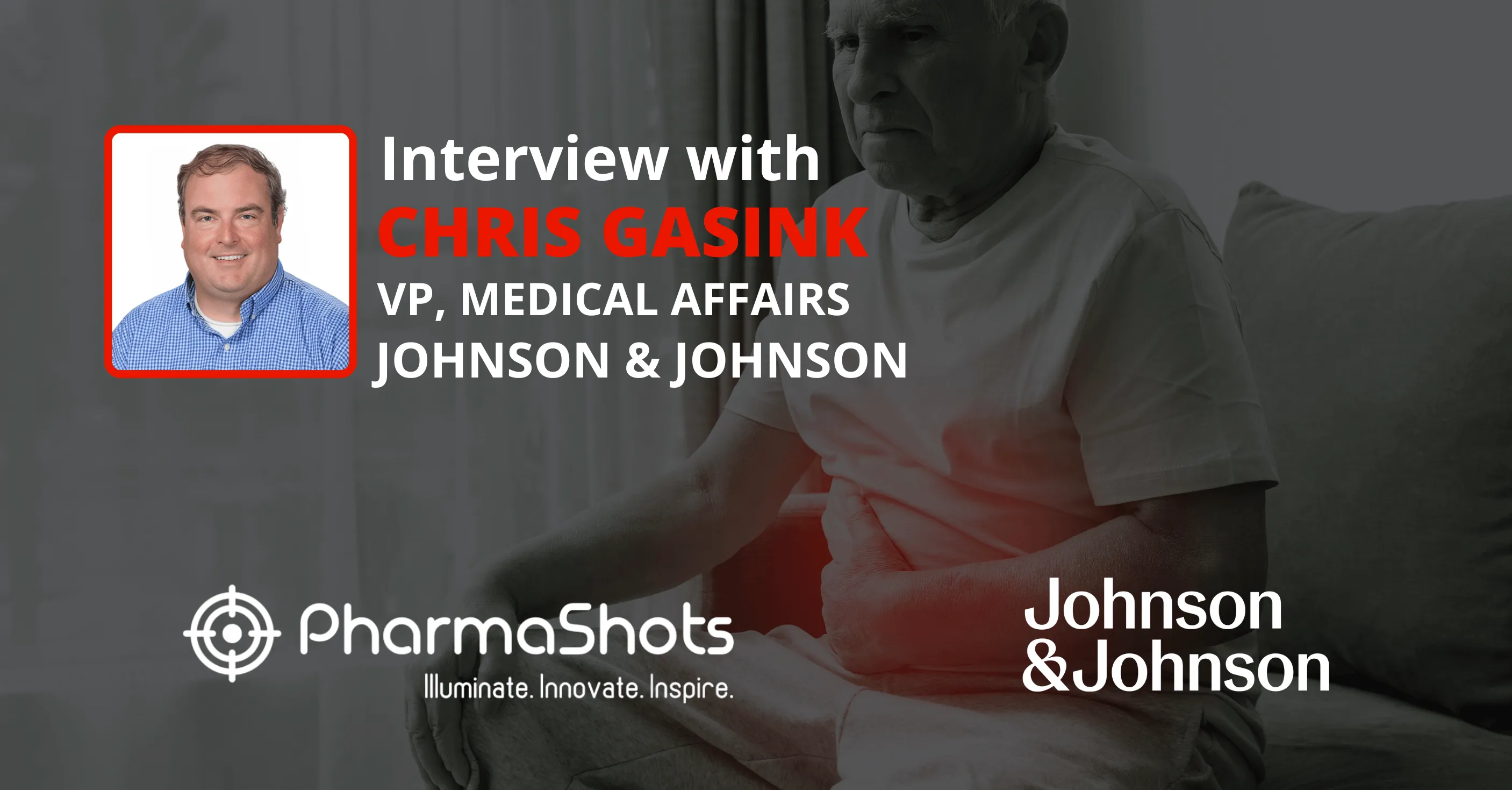
PharmaShots Interview: Janssen’s Alyssa Johnsen Shares Insights on the New Clinical data of Tremfya (guselkumab) Presented at ACR 2021 and Published in Arthritis & Rheumatology
In an interview with PharmaShots, Alyssa Johnsen, MD, Ph.D., Vice President, Rheumatology and Maternal-Fetal Health Disease Area Leader at Janssen Research & Development shares her views on the P-III DISCOVER-1 & 2 Studies of Tremfya (guselkumab) for the treatment of psoriatic arthritis in ACR 2021 and published in Arthritis & Rheumatology
Shots:
- The P-III DISCOVER-1 & 2 trials evaluate Tremfya (SC) vs PBO in 381 & 739 patients with active PsA
- The results showed that Tremfya inhibited radiographic progression & maintained low rates of progression @ 2yrs. in biologic-naïve patients, lower mean scores for all six BASDAI components, improvements in ASDAS @24wks. improvements in joints, axial symptoms, enthesitis, dactylitis along with improvement in pain with 32% & 33% of patients achieved ≥20% & ≥50% improvement
- The safety profile was consistent b/w adults with active PsA @ 2yrs. & adults with PsO through 5yrs. The therapy is approved in the US, Canada, Japan, & other countries globally for plaque PsO & active PsA
Tuba: Let us talk about Psoriatic Arthritis and Explain the epidemiology of Active Psoriatic Arthritis (PsA).
Alyssa Johnsen: Psoriatic arthritis (PsA) is a complex, immune-mediated inflammatory disease that manifests with symptoms including peripheral joint inflammation, enthesitis, dactylitis, axial disease, fatigue, and the skin lesions associated with plaque psoriasis (PsO). Simply put, PsA causes pain, stiffness, and swelling in and around the joints. It commonly appears between the ages of 30 and 50 but can develop at any age. The exact cause of active PsA is unknown, but genes, the immune system, and environmental factors are all believed to play a role in its onset.
Up to 30 percent of people with plaque PsO also develop active PsA, and patients often experience comorbid diagnoses such as obesity, cardiovascular diseases, anxiety, and depression.
Tuba: Can you brief me about TREMFYA (guselkumab) including its MoA and other details?
Alyssa Johnsen: Our research has demonstrated that the IL-23 pathway is an important driver of inflammatory diseases like PsO and PsA. Within the immune system, the interaction between IL-23 and its receptor drives the differentiation and survival of Th17 cells, which produce inflammatory cytokines that stimulate inflammation and cause the symptoms of PsO and PsA. TREMFYA® (guselkumab) is the first fully human monoclonal antibody that selectively binds to the p19 subunit of IL-23 and inhibits its interaction with the IL-23 receptor. By blocking the IL-23 pathway, TREMFYA inhibits the release of important pro-inflammatory cytokines and chemokines. Data has shown the important role TREMFYA can have in helping patients manage their disease.
Tuba: Would you like to share the study design of DISCOVER-1 and DISCOVER-2 clinical trials?
Alyssa Johnsen: The Phase 3, randomized, double-blind, placebo-controlled DISCOVER-1 and -2 trials evaluated the efficacy and safety of TREMFYA in over 1,900 adult patients with active psoriatic arthritis. Across both trials, patients treated with TREMFYA showed greater improvements in the signs and symptoms of active PsA based on the American College of Rheumatology 20 (ACR 20) response compared with placebo at week 24. These improvements included joint and axial symptoms as well. TREMFYA treatment also resulted in lower mean scores for all six Bath Ankylosing Spondylitis Disease Activity Index (BASDAI) components as well as greater improvements in Ankylosing Spondylitis Disease Activity Score (ASDAS) compared with placebo through week 24. TREMFYA treatment was shown to have provided robust and durable improvements in the signs and symptoms of active PsA and was well-tolerated through one and two years, respectively, in DISCOVER -1 and -2.
Each DISCOVER study began with a screening phase of up to six weeks, followed by a blinded treatment phase of 52 weeks in DISCOVER-1 and approximately 100 weeks in DISCOVER-2, which included a placebo-controlled period from week 0 to week 24 and a blinded active treatment period in the weeks following. The studies also included a safety follow-up phase through weeks 60 and 112, respectively. Both studies assessed additional clinical outcomes to ACR20, including ACR50/70, resolution of soft tissue inflammation, enthesitis and dactylitis, improvement in physical function, skin clearance (Investigator’s Global Assessment [IGA] score), and general health outcomes (SF-36 Physical Component Summary [PCS] and Mental Component Summary [MCS] scores).
Tuba: Shed some light on the data obtained from Phase 3 DISCOVER-1 and DISCOVER-2 clinical trials.
Alyssa Johnsen: In both DISCOVER-1 and -2, TREMFYA demonstrated durable improvements in joint manifestations and disease activity, and statistically significant improvements vs placebo in ACR20 at week 24, the studies’ primary endpoints. Higher proportions of TREMFYA patients also attained ACR50 or ACR70 response vs placebo in both studies.
The majority of TREMFYA-treated patients in DISCOVER-2 who achieved an ACR20, ACR50, or ACR70 response at week 52 maintained the response at week 100, with response rates for ACR50 and ACR70 increasing through the second year of treatment. The majority of TREMFYA patients also achieved complete skin clearance (IGA score of 0) at week 100.
Enthesitis and dactylitis resolution rates at week 100 showed amelioration of these signs and symptoms of arthritis was durable through two years.
In DISCOVER-2, low rates of radiographic progression, a key indicator of structural damage, were seen from week 0–100 across both TREMFYA dosing regimens. Mean changes in total van der Heijde Modified Sharp (vdH-S) scores indicated less radiographic progression from week 52–100 than from week 0–52 in all three treatment groups (q4w, q8w, and patients who crossed over from placebo to TREMFYA at week 24). The studies also showed that TREMFYA improved axial symptoms based on mean changes from baseline in vdH-S scores and the BASDAI, respectively. I will note that q4w dosing, vdH-S, and radiographic progression are not in the US FDA label for TREMFYA.
In addition, TREMFYA provided consistent and durable improvements in patient-reported pain through two years of the DISCOVER-2 trial across multiple instruments.
Finally, the data demonstrated a stable safety profile through one year in DISCOVER-1 and two years in DISCOVER-2 for adults with active PsA, which was consistent with the TREMFYA safety profile through five years in PsO established in the VOYAGE trials.
Tuba: Can we have a glance at other molecules in the pipeline?
Alyssa Johnsen: We currently have a very strong pipeline in development, with a number of molecules that will advance our research and progress towards providing safe, effective treatments for immune-mediated diseases in dermatology, rheumatology, gastroenterology, and maternal-fetal immunology. At the moment, we are leading the way towards next-generation treatments with our investigations into three new molecular entities, including nipocalimab, a fully human monoclonal antibody that binds to the neonatal Fc receptor; JNJ-2113, an oral IL-23 receptor inhibitor; and bermekimab, the only antibody targeting IL-1a currently in clinical development for atopic dermatitis and hidradenitis suppurativa – both diseases with substantial unmet need.
Tuba: For which other Indications TREMFYA is being developed in addition to PsO & PsA?
Alyssa Johnsen: TREMFYA is the first and only selective IL-23 inhibitor therapy approved in the U.S. to treat both adults with moderate to severe plaque PsO who are candidates for systemic therapy or phototherapy, as well as adults with active PsA. There are also current trials investigating TREMFYA in Crohn’s disease (CD) and ulcerative colitis – Janssen recently announced positive topline results from the Phase 2 GALAXI study in adults with moderately to severely active CD – as well as lupus nephritis, giant cell arteritis, and pediatric psoriasis. Please note that TREMFYA is not currently approved for these indications in the U.S.
Tuba: What is your commercialization strategy after the U.S. FDA approval?
Alyssa Johnsen: TREMFYA is approved in the U.S. for the treatment of moderate to severe plaque PsO and adults with active PsA. We are continuing to drive TREMFYA research and commercialization opportunities in order to bring better treatment options to patients living with immune-mediated disease.
Tuba: What other geographies Tremfya is expecting approval for PsA?
Alyssa Johnsen: TREMFYA is approved for the treatment of adults with active PsA in the US and EU. In 2021, it was approved in Korea and Australia, where it was also listed in Australia’s Pharmaceutical Benefits Scheme (PBS). We continue to investigate other geographic opportunities in order to provide options to patients with chronic immune-mediated disease.
Source: Health Magazine
About Author: Alyssa Johnsen is the Vice President, Rheumatology and Maternal-Fetal Health Disease Area Leader for the Immunology Therapeutic Area at Janssen Research & Development. She is responsible for driving scientific leadership in rheumatology and maternal-fetal health, overseeing innovative compounds across multiple phases of development. Alyssa received her bachelor’s degree in Chemistry at Duke University and her Ph.D. in Immunology and M.D. at Case Western Reserve University. She completed residency training in internal medicine at the Massachusetts General Hospital and a fellowship in rheumatology at the Brigham and Women’s Hospital.
Related Post: PharmaShots Interview: Alto Neuroscience’s Dr. Amit Etkin Shares Insights on the Future of Psychiatric Medicines
Tags

This content piece was prepared by our former Senior Editor. She had expertise in life science research and was an avid reader. For any query reach out to us at connect@pharmashots.com














